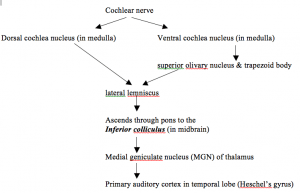Pathways

- Ventral cochlea – encodes intensity information
- Dorsal cochlea – encodes information and analyzes quality of sounds (e.g., differentiates phonemes)
- Organ of Corti –the auditory transductor, which consists of cells which bend in response to sound waves
- Info from one ear may travel via a number of different routes to reach the auditory cortex of both hemispheres
- Central Auditory Pathways are Unlike Any Other Ascending Pathways Due to
- Presence of accessory nuclei that modulate input (see below)
- Bilateral representation of auditory impulses on each side
Efferent Cochlear Bundle
The CNS can influence its own sensory input to protect us in conditions of very loud noise and to enable us to “sharpen” our perceptions of auditory stimuli
- Crossed and uncrossed fibers from the olivocochlear bundle project peripherally from the brainstem to the cochlea forming the efferent cochlear bundle
- Suppresses auditory nerve activity by inhibiting the receptivity of the organ
- Auditory sharpening – the processes whereby relay nuclei in the auditory pathways differentially inhibit impulses concerned with certain frequencies thereby enhancing the frequencies of other sounds
Auditory Cortex
Primary Cortex
- areas 41 and 42 – mostly buried in the insula
- Contains Heschel’s Gyri
- Cortical auditory area receives geniculotemporal fibers from the MGN via the internal capsule
- Each cochlea is represented bilaterally however, cortical response is greatest contralaterally.
Sound Localization
A 2-phase process
- Convergence and comparison of auditory input from the 2 ears
- Distribution of the analysis to the appropriate side of the system
- Trapezoid body and Superior Olivary Nucleus are essential to localization
Association Cortex
- Laterally specialized – with dominant hemisphere mainly concerned with processing speech and language and nondominant hemisphere concerned with nonverbal auditory stimuli
Brain Damage and Hearing Impairment
- Destruction of the cochlea, cochlea nerve or cochlea nuclei (both dorsal and ventral) results in complete ipsilateral deafness
- Damage to lateral lemniscus – bilateral partial deafness, greatest in contralateral ear
- Complete cortical deafness is very rare, as it requires lesions affecting the transverse gyri of Heschel, bilateral
- The clinical signs of damage to the auditory nerve are deafness and tinnitus
- Conduction deafness – interference with passage of sound waves through the external or middle ear (e.g., wax build up in outer ear or otitis media) – deafness is never complete or total
- Nerve deafness – results from damage to cochlear nerve or receptor cells
Common causes of deafness
- Old people progressively lose hearing (Presbyacusis). High frequencies are lost first. Starts relatively early in life (during the twenties)
- Otosclerosis – most common adult cause of hearing loss. Autosomal dominant genetic disorder Characterized by fusion of stapes to oval window causing difficulty of movement followed by eventual cessation of ear ossicle movement. It is amenable to surgery.
- Persistent loud noises can cause cells to die (frequency dependent).
- Infection Viruses e.g. mumps. German measles during pregnancy can cause complete destruction of cochlear nerve in fetus.
- Middle ear infections e.g. Otitis media – bacterial infection causing swelling and outward bulging of tympanic membrane, pain and pus collection in middle ear. Most common in children as eustachian tubes are not fully formed and thus don’t drain well into nasopharynx.
Brain damage, aphasia, and agnosia
Sensory/receptive aphasia
- inability to differentiate speech sounds
- caused by lesions in superior temporal gyrus in the region adjacent to primary auditory cortex of dominant hemisphere
Word Deafness/sensory aphasia
- person can hear what is said, but cannot interpret the words
- lesions in Brodmann’s area 22 in dominant hemisphere
Auditory amnesic aphasia
- inability to repeat series of words presented acoustically, although ability to repeat single words remains intact
- lesions in middle temporal gyrus (further away from primary auditory projection areas)
Acoustic agnosia
- inability to differentiate nonverbal speech sounds
- right hemisphere lesions